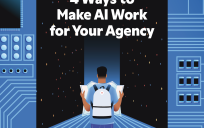This interview is an excerpt from our recent guide, 25 Innovations You Should Know in 2018.
Imagine you’ve recently gotten married. You’re excited about this new step in your life, but you know there’s a bit of paperwork you need to do to really get started. Instead of guessing where you go to update your name, tax filing status and other paperwork, you log onto a central website and simply type, “I just got married. How do I change my information?”
An agent responds directly to your message in a chat box, letting you know they can help. Then the agent walks you through the workflow to process your changes. If you hit a roadblock, that agent connects you with an agency employee to address the specific challenge. But that employee isn’t asking you redundant questions, because they already have a record of what you’ve done so far in the process.
This scenario might be a stark contrast to what you’re used to experiencing when submitting a complicated request to a government agency. But in a recent interview, Chief Technology Officer Bob Osborn at ServiceNow explained that this interaction must become the new norm for government. He explained that rising citizen demands make it imperative that agencies pursue new solutions, including intelligent agents, to create seamless experiences for constituents.
“The challenge most agencies have today is that employees internally and the citizens that they serve are being conditioned to expect a level of service in their personal lives through commercial capabilities that they interact with,” Osborn said. “These have really conditioned them to expect this level of automated service when they get to work, too.”
To provide this level of service, many agencies are turning to platforms that consolidate constituent touchpoints and data. “It starts with a philosophical shift from focusing on individual application development that supports a specific function within a business unit like HR or logistics and focuses more on a broad platform approach of management, where you have easy to use applications that aggregate information from a multitude of systems of record,” Osborn explained.
This consolidation allows for service agents to leverage a wide range of information to support a single customer, and it avoids intaking redundant information each time a constituent submits a new request. However, modern platforms do more than consolidate data. They also leverage artificial intelligence to do more with collected data and better serve citizens.
“We see agencies moving into a platform that allows them to provide the same type of user experience as private websites and actually begin to introduce intelligent agents, to make suggestions and allow for decisions based upon someone’s role and the permissions they have, in order to take action very quickly and easily,” Osborn said.
Artificial intelligence can synthesize data from a wide breadth of citizen requests, inquiries and interactions to pinpoint common interest or problem areas. Then artificial intelligence can craft automated workflows, as well as communication for citizens, to address those issues. Intelligent agents, also known as chatbots, can also walk users through those processes – improving the efficiency of constituent interactions while maintaining a personalized touch to those communications.
Service platforms that leverage artificial intelligence can transform the way constituents request and receive information from government agencies. But Osborn said some IT and customer service leaders are reticent to chart this advanced territory and adopt complex solutions.
The key is to take what Osborn called the “crawl, walk, run approach” that considers current agency solutions and processes, before taking incremental steps toward automation and artificial intelligence.
“We offer a customer success journey,” he said. “We sit down with representatives of an agency and we see where they are today, what technologies they have deployed, and then we map out how they get from where they are today, to this very rich and immersive user experience.”
By taking incremental steps to identify customer experience pain points – instances where support agents are dedicating significant resources or where constituents encounter redundant services – agencies can strategically invest in automation and artificial intelligence. They can ensure the service is improved, even as costs are cut and employees regain valuable time in their days.
“The expectation of our citizen users and employees today is so radically different from what they experience at work, and it doesn’t have to be that way,” concluded Osborn. With a common service platform that leverages artificial intelligence, government can meet the service demands of today.






Leave a Reply
You must be logged in to post a comment.